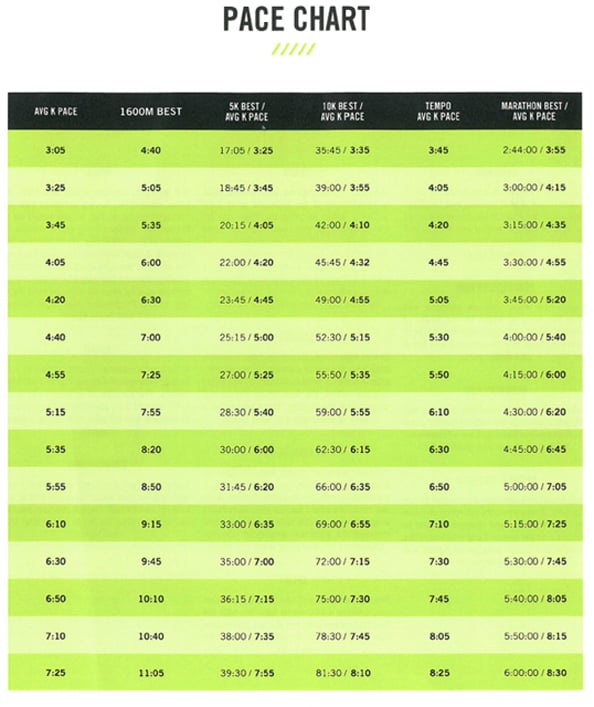Are you running the Nike DXB 10k race? Yep, we are too. Are you fully prepared, trained and raring to go? Nope, neither are we. But panic not, as we have enlisted Tom Woolf, Head Coach, Nike Running, Middle East to provide us with a weekly training plan that will see us crossing that finishing line with a smile on our faces, well sort if…
Anyone can conquer a 10k – the trick is in staying positive or consistent throughout. Irrespective of your fitness level, training for a 10k should include four types of workouts – speed, endurance, progression and recovery.
Tom says: “First of all it is good to understand the different paces you can run at (checkout the Pace Chart below). For example, if your average pace is 4:05 minutes per kilometre, then your mile (1,600m) pace is 6:00 minutes and your tempo (steady) pace is 4:45.”

The Pace Chart
How To Prepare For The Nike Run
WEEK ONE: GET UP AND RUNNING
Day 1: Start with a progression run* of 3-5k. Build up your pace so that your last kilometre is faster than your first.
Day 2: Speed day aka fartlek* on a track with a series of 200m, 400m, 600m and 800m runs.
- If you’re feeling strong, split the 200m, 600m and 800m, so that you are running the first half at an easy pace and the last 200m at a faster pace (just run the 200m at full speed).
Tom’s ideal sequence:
· 200 m at 1,600m pace (twice)
· Split 800m – 600m at 5k pace (this means that the first 400m or 300m are at a 5k pace and the last 400m or 300m at a faster pace)
· Split 200m at 1,600m pace
· 400m at 5k pace
· Split 800m – 600m at 5k pace
· Split 200m at 1,600m pace
· 400m at 5k pace
· 200 m at 1600m pace (twice)
- If you’re looking to increase speed, split the 800m and 600m run at your 5k place and the 200m run at your 1600m (1 mile) pace.
Tom’s Tip: When you split a run, you generally run two paces in one run. For example, in the above example, if I (avg k pace is 4:55) split a 200m run – I would run the first 100m at 5:25 (5k pace) and the last 100m at a much faster pace.
Day 3: Reward your body with a break. Run a few progression kilometres or do an N+TC workout or take the day off.
Day 4: More fartlek speed runs of 1,600m followed by 400m followed by 800m. Monitor your pace at each run and amp up or down. Repeat twice with recovery periods in between
- If you want to increase speed, run the 1,600m at your 10k pace, 400m at your 1,600m pace and 800m at your 5k pace.
Day 5: 3-5k progression run.
Day 6: Endurance run* of 5-6k run that will help your body and mind get used to the distance. Study how you paced yourself using the Nike+ Running app so that you know whether you need to improve on endurance or speed.
Day 7: Rest, N+TC session or a few easy kilometres.
N+TC can be found on the free app
THE LINGO*
Don’t understand the instructions. Here’s a mini glossary
Progression run: A run with structured pace increases from beginning to end. Essentially you get faster and faster but at a steady rate.
Fartlek: A speed workout with a series of faster runs with a recovery interval in between. The length and speed of the runs, as well as the recovery intervals, is totally up to you.
Endurance run: Often a long-distance run maintaining continuous running form over distances of at least 3k.











